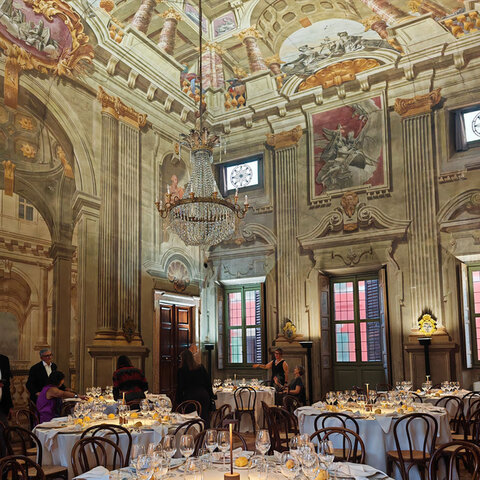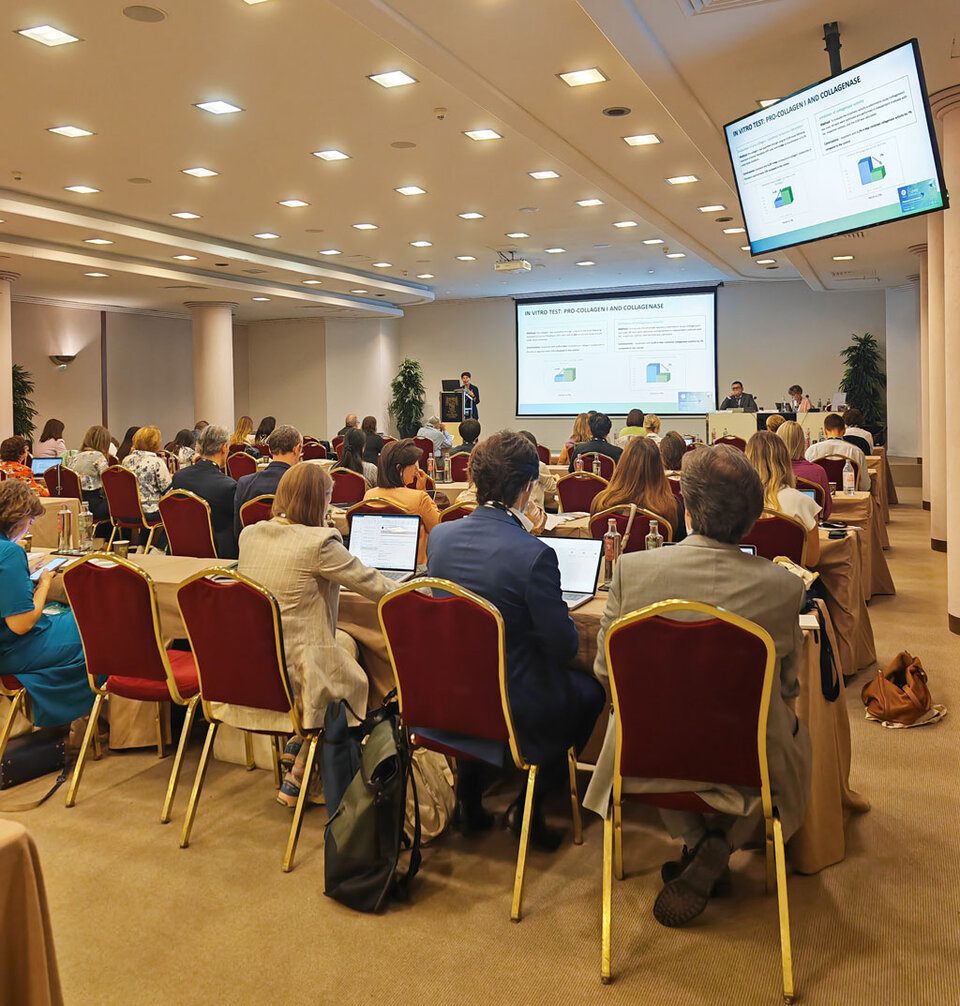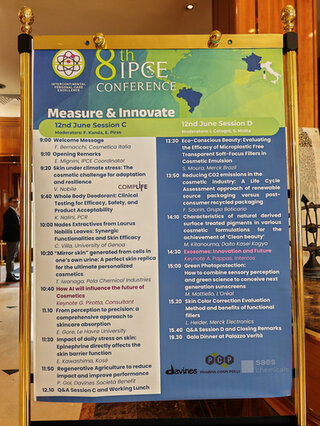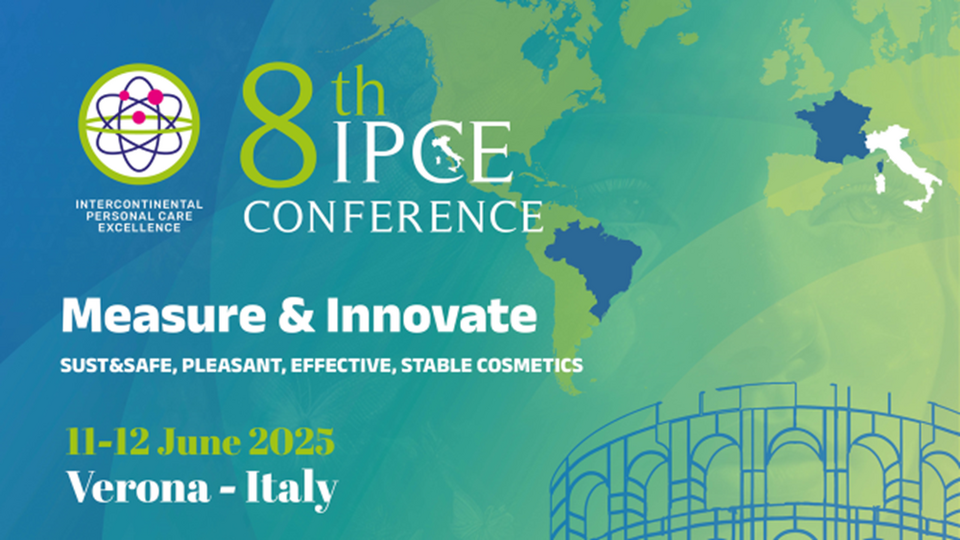REPORT
8TH INTERCONTINENTAL PERSONAL CARE EXCELLENCE CONFERENCE
Measure & Innovate
The 8th edition of the IPCE Conference, organised by SICC (Italian Society of Cosmetic Chemists) took place on 11 and 12 June at the Hotel Leon D'Oro in Verona.
The main topic of this year was “Measure & Innovate” and the event acted, as usual, as a bridge between the last IFSCC Congress, held in Foz du Iguassù, and the next one, which will take place in Cannes. The scientific programme was drawn from the best posters presented at the last IFSCC Congress, which alternated with internationally renowned keynote speakers.
The keynote speakers looked to the future, delivering lectures that questioned how new technologies will help formulators create better skin solutions, how AI will influence the future of cosmetics, and what it means to be innovative today and whether it is possible to bring innovation to the cosmetics industry. Cosmetic formulation today faces unprecedented challenges: products must prove to be safe and formulated according to environmental and ethical sustainability criteria.
Moreover, the need for new products that can address different needs in a single formulation requires research into new ingredients, always keeping in mind that the final product must be safe, pleasant, effective and stable. Biotechnology can certainly help meet today's challenges, but it has objective limitations in terms of cost, process complexity and consumer perception of risk.
Talking about new technologies and how they may help the formulation sector in the future, the lecture delivered by Dr. Romanowski explained that AI may facilitate the work of the formulator, e.g. by predicting the toxicological profile of a substance or simulating people's perceptions, but it should not be interpreted as a guarantee as it always requires final verification by experts. The presentation also showed that AI, according to Perry Romanowski, will not replace cosmetic chemists, but cosmetic chemists who know how to use AI will replace those who don’t.
Undoubtedly, the value of this year's conference was that it brought together speakers from all over the world, from companies and organisations ranging from universities, to ingredient manufacturers, to institutions.
One of the main topics discussed was the research for sustainable innovation. Particularly adhering to this theme was the presentation by Dr. Di Lorenzo, from Naples University. She presented a study analysing the use of annurca apple peel extract as a natural skincare solution, thanks to its anti-melanogenic and antioxidant activity. I found this study of particular interest because it explores a natural alternative to treatments that may be more invasive, and at the same time it may contribute to growing evidence supporting natural ingredients in skincare.
The presentation by Dr Giovanna Pressi, from Aethera Biotech, combined sustainable innovation and tradition. From the hydrolysate of meristematic cells of 𝘔𝘦𝘯𝘵𝘩𝘢 𝘢𝘳𝘷𝘦𝘯𝘴𝘪𝘴, known for its medicinal properties since ancient times, the presentation showed us a new ingredient derived from this plant, a mixture of water-soluble peptides designed to promote healthy ageing by reducing fine lines and deep wrinkles. Thanks to its neurocosmetic activity, it improves skin radiance and smoothness, promoting a stress-free appearance.
Another important topic treated in the presentations was the development of personalised products. Consumers’ demand for customised cosmetics is increasing and researchers are conducting studies to produce cosmetics that take into account the different variability of absorption between individuals and different biodiversity.




In this regard, we attended Dr. Iwanaga’s presentation, from Pola Chemical Industries, Japan. With his work ““Mirror skin” generated from cells in one’s own urine: A perfect skin replica for the ultimate personalized cosmetics”, Dr. Iwanaga won the2024 IFSCC Johann Wiechers Poster Award at the IFSCC Congress in Brazil. In this study, induced pluripotent stem cells (iPSCs) expressing intrinsic characteristics of donor skin, such as the inflammatory response to UVB rays, were isolated from non-invasively collected urine samples. This could be used as a model to develop customised beauty products targeting specific characteristics.
During the presentations, emerging technologies -such as plant exosomes - were also introduced. Dr. Pappas, from Intercos, held a keynote speech on innovations and future of exosomes. Exosomes mediate crosstalk interaction between cells and perform numerous functions, such as the regulation of gene expression, modulation of immune system and intracellular signalling. Plant exosomes can be engineered and used to induce rejuvenating pathways and skin's natural repair mechanisms, thus representing an alternative to exosomes isolated from human sources.
Another emerging technology presented was the microneedle delivery system in the cosmetics sector. In particular, Dr. Hisama, from Toyo Beauty, introduced a study focused on developing a novel transdermal permeation and delivery technology with a combination of microneedles and nano capsules of natural origin, for use in anti-ageing cosmetics. Compared to direct injection, they enable self-administration by users. Therefore, they are increasingly used by patients with cosmetic needs.
Scientific sessions were alternated with moments of interaction between the participants and the speakers, and the chance to network in prestigious cultural settings, such as the historic Palazzo Verità Poeta, contributed to making this event unique. The premiere of the Opera “Nabucco” by Giuseppe Verdi at the Verona Arena was particularly appreciated, especially by those who had not had the opportunity to participate in such an important performance before.
The event ended with a closing speech by the organisers, who are already thinking about the next bridge connecting the IFSCC congresses (in Cannes and Adelaide). As per the intentions of the IPCE board, it will once again take place in an Italian location, ideally a UNESCO cultural heritage site.
Giulia Donatiello
Editorial Department, Tks publisher

References and notes
- Karković Marković, A.; Torić, J.; Barbarić, M.; Jakobušić Brala, C. Hydroxytyrosol, Tyrosol and Derivatives and Their Potential Effects on Human Health. Molecules 2019, 24, 2001. https://doi.org/10.3390/molecules24102001
- Nunes, A., Marto, J., Gonçalves, L., Martins, A.M., Fraga, C. and Ribeiro, H.M. (2022), Potential therapeutic of olive oil industry by-products in skin health: a review. Int. J. Food Sci. Technol., 57: 173-187. https://doi.org/10.1111/ijfs.15384